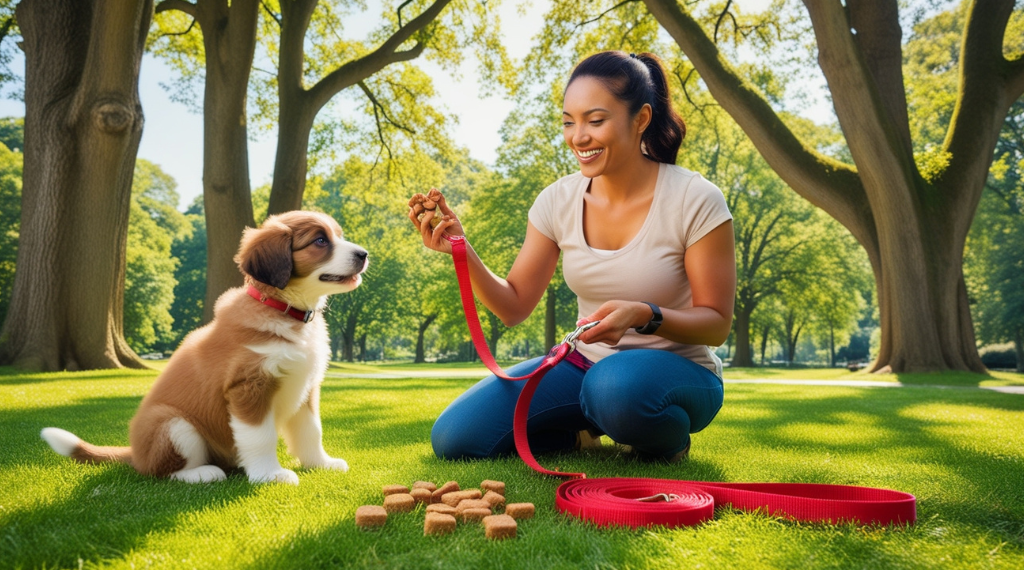Training your dog can be one of the most rewarding experiences, but it requires patience, consistency, and the right approach.
Whether you have a playful puppy or an older dog, these 20 tips for your dog training will help you establish a strong foundation and build a positive relationship with your furry companion.
1. Start Early
Puppies are like sponges, and the earlier you start training, the easier it is for them to learn. Begin with basic commands like “sit” and “stay” to build their confidence.
2. Use Positive Reinforcement
Positive reinforcement is key to effective dog training. Reward your dog with treats, praise, or playtime when they exhibit desired behavior. This encourages them to repeat those actions.
3. Keep Sessions Short
Dogs have short attention spans, especially when they’re young. Aim for 10 to 15-minute training sessions to keep them engaged and prevent boredom.
4. Be Consistent
Consistency is crucial in dog training. Use the same commands and gestures each time you train, and make sure all family members do the same. Mixed signals can confuse your dog.
5. Train in a Distraction-Free Environment
Start training in a quiet area with minimal distractions. Once your dog masters commands in a calm environment, gradually increase distractions to test their focus.
6. Use High-Value Treats
For successful training, use high-value treats that your dog loves. Reserve these special treats for training sessions only, so they remain exciting and motivating.
7. Be Patient
Training takes time. Some dogs pick up commands quickly, while others may need more repetition. Patience and persistence will pay off in the long run.
8. Focus on One Command at a Time
It’s tempting to teach multiple commands at once, but focusing on one command per session is more effective. Once your dog has mastered a command, move on to the next.
9. Practice Regularly
Training shouldn’t be a once-in-a-while activity. Make it a regular part of your daily routine. Frequent practice helps reinforce commands and keeps your dog’s skills sharp.

10. Use a Clicker
Clicker training is a popular method that pairs a clicking sound with a reward. It’s a clear and consistent way to signal to your dog that they’ve performed the desired behavior.
11. Stay Calm and Positive
Dogs can sense your emotions, so stay calm and avoid frustration. If you’re having a tough training session, take a break and try again later. A positive attitude keeps your dog motivated.
12. Socialize Your Dog
Proper socialization is an essential part of training. Expose your dog to new environments, people, and other dogs in a controlled and positive way to reduce anxiety and fear.
13. Introduce Hand Signals
Along with verbal commands, use hand signals to reinforce training. This helps your dog understand commands visually and can be especially helpful for older dogs with hearing loss.
14. Gradually Increase Difficulty
Once your dog is comfortable with basic commands, gradually increase the difficulty by adding distractions or practicing in different locations. This challenges your dog and keeps them engaged.
15. Reward Good Behavior, Ignore Bad Behavior
Instead of punishing bad behavior, try ignoring it and redirecting your dog’s attention to something positive. Dogs thrive on attention, and ignoring unwanted behavior can be an effective way to discourage it.
16. Use Commands with Purpose
Avoid giving commands casually. When you tell your dog to “sit” or “stay,” make sure there’s a reason behind it. This teaches your dog that commands have meaning and helps them understand when and why to follow them.
17. Break Commands into Small Steps
For complex commands, break them into smaller steps. For example, teaching your dog to “roll over” might start with getting them to lie down first. Reward each small step to build up to the full command.
18. Practice Recall Training
A reliable recall, or getting your dog to come when called, is one of the most important commands. Practice this often in different environments to ensure your dog responds every time, even with distractions.
19. Train with Toys
Incorporate your dog’s favorite toys into training sessions. Toys can be used as rewards or as part of training games that keep your dog engaged and excited to learn.
20. End on a Positive Note
Always finish training sessions on a high note. End with a command your dog knows well, followed by praise and rewards. This leaves your dog with a sense of accomplishment and excitement for the next session.
Conclusion
Training your dog is a journey, not a destination. By following these 20 tips for your dog training, you’ll create a strong bond, instill good behavior, and have a well-mannered companion by your side. Remember, the key to successful training is patience, consistency, and positive reinforcement. With time and effort, your dog will master the skills and behaviors that make them a joy to be around.
Frequently Asked Questions (FAQ)
Q1: How long does it take to train a dog?
The time it takes to train a dog depends on the dog’s age, temperament, and the consistency of training. Some dogs learn basic commands in a few weeks, while more complex training can take months.
Q2: Can I train an older dog?
Yes, older dogs can be trained! While puppies are more adaptable, older dogs can still learn new commands and behaviors with patience and consistency.
Q3: What’s the best time of day to train my dog?
The best time to train your dog is when they are alert but not overly excited. Many people find that short sessions after meals or walks work well.
Q4: Should I hire a professional trainer?
If you’re struggling with specific behaviors or want personalized guidance, a professional trainer can be a great resource. They can offer tailored advice and techniques to help you achieve your training goals.
Q5: What if my dog doesn’t respond to treats?
If your dog isn’t motivated by treats, try using toys, praise, or playtime as rewards. Every dog is different, so find what excites and motivates them to learn.
Q6: How do I stop my dog from barking during training?
If your dog barks during training, it could be due to excitement or frustration. Take a break, use a calming voice, and refocus their attention on the command. If barking persists, consider consulting a trainer for additional tips.
Final Thoughts
Training your dog can be a challenge, but it’s an essential part of being a responsible pet owner. With these 20 tips for your dog training, you’re on your way to having a well-trained, happy, and healthy dog. Keep it positive, stay patient, and celebrate the small wins along the way!

